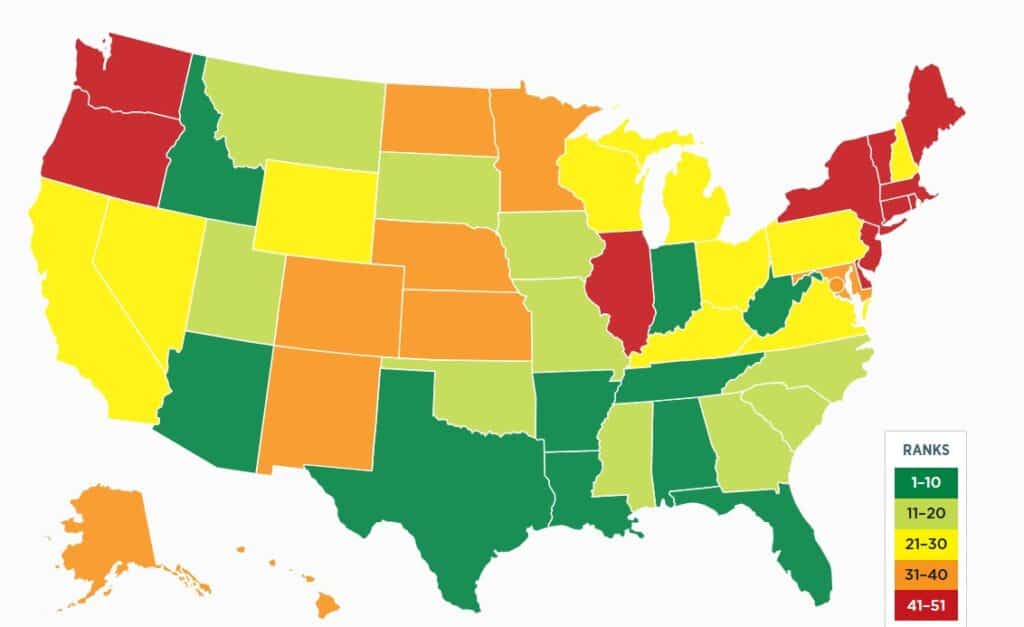The Heritage Foundation recently released its 2025 Education Freedom Report Card, which evaluates and ranks all 50 states and the District of Columbia according to key components that determine parents’ freedom to choose the best education for their children.
The report also lists states that moved toward more education freedom in 2025.
The publication’s introduction quoted philosopher John Stuart Mills’ warning against state control of education because it allowed leaders to mold people “to be exactly like one another” in a way that pleases “the predominant power in the government.”
Heritage noted that America has failed to follow Mill’s guidance, “Rather than encouraging a diverse and pluralistic system of schools, Americans created a public school system characterized by ZIP code assignment, regulatory capture by far left-leaning employee unions, high spending, low academic achievement and pervasive efforts to [mold] the views of children in disturbing ways. “
The 2025 report card lists the five states with the highest levels of education freedom in dark green: Florida, Arizona, Idaho, Arkansas and Louisiana. The states with the lowest levels of educational freedom, illustrated in red, were Connecticut, Massachusetts, Vermont and Rhode Island – with Maine at the very bottom of the list.

States were rated on four components: education choice, teacher freedom, transparency and return on investment.
Education choice includes whether a state offers education savings accounts for education expenses and what proportion of students qualify for these programs. It also includes the proportion of charter schools to public schools; the proportion of students in charter, private and home schools; and the amount of regulation burdening alternatives to government schools.
Teacher freedom rankings considered whether states allow new teachers to be “certified through alternative pathways” or if they require traditional teacher licensing. This category also measured the proportion of school districts with chief diversity officers who “limit academic freedom in the classroom” and whether a state “grants full reciprocity to teachers who complete their certification in other states.”
The Heritage Foundation defines the third component, Transparency, as whether “the education system gives parents information to make the best decisions about their children’s education.” States were also rated on whether they had enacted a “Parents’ Bill of Rights.”
Heritage researchers also looked to see if a state protected teachers and students from critical race theory and transgender ideology – or if it compelled indoctrination in these radical ideologies and forced students and staff to use a student’s “chosen name and pronouns.
Transparency in education also included parents’ right to access curricula and materials; a state’s protection of public comments at school board meetings; and the timing of school board election cycle.
The report explains the latter, “This variable indicates whether states hold school board elections on cycle with the general election. Teachers’ unions often lobby for off-cycle elections so that they can ensure a larger turnout from their members. This makes it more likely that union-friendly school board members are elected.”
Return on investment was determined by dividing average fourth and eighth grade state scores on the National Assessment of Educational Progress by its per-pupil spending. Researchers also looked at the ratio of teachers to non-teaching staff, noting, “Much of the K–12 public school spending has resulted in more school administrators, not investments in teachers and resources to improve education quality.”
States were given a separate civics education rating, which included whether a year-long civics course was a requirement for high school students and quantification of “how many classical education schools each state has per 100,000 K–12 students.”
Civics education was also rated by “whether states require students to pass the U.S. Citizenship and Immigration Services Test, or an equivalent,” as well as a state’s performance on the NAEP’s Civics Test.
The Heritage Foundation listed major gains just this year as more states embrace education freedom:
- Tennessee (new education savings account (ESA) program).
- Idaho (new personal use tax credit).
- Indiana (expanded eligibility for voucher program).
- Louisiana (new ESA program).
- Missouri (expanded tax credit funded ESA).
- New Hampshire (expanded eligibility for ESA program).
- Wyoming (new ESA).
- Perhaps most important of all, Texas joined the fraternity of states providing universal choice to K–12 students.
Despite those advances, the state education survey indicates how much more work is needed to allow parents the freedom to provide their children with the best education possible.
Focus on the Family and Family Policy Alliance have produced a comprehensive resource, Equipping Parents for Back-to-School, that empowers parents and concerned citizens as they work to improve government schools.
Equipping Parents helps you understand your rights and your children’s rights, prepares you to take action if needed, explains state and federal laws related to a variety of school issues and gives guidance for talking with your child about sensitive issues.
The free, downloadable PDF has sections dealing with different areas of concern within local schools, such as classroom curriculums and textbooks, sports teams and locker rooms, school health clinics and counseling offices, and school internet and computers.
Then, the resource equips you with ideas for responding and protecting your child.
Related Articles and Resources
Check out your state’s education freedom assessment ranking.
FBI Reports: Crime in Schools: Almost 1.3 Million Incidents from 2020-2024
Gender Ideology Sours Feds on Comprehensive Sex Ed
Huge Increase in Home Schooling Numbers
More than Twenty States Limit Smartphone Use in Schools
Reading and Math Scores Plummeted During Pandemic, New Report Finds
Trump Ends Radical Indoctrination, Promotes Education Freedom
Sex Educators Say ‘Early Grades May Be the Best Time’ to Introduce Children to LGBT Issues
Sexualizing Schoolchildren: Comprehensive Sex Ed
What’s Happening in Schools? Why We Need Educational Freedom
Images from Shutterstock and The Heritage Foundation.
Image from Shutterstock.










